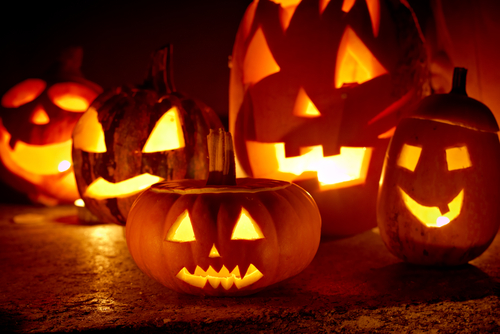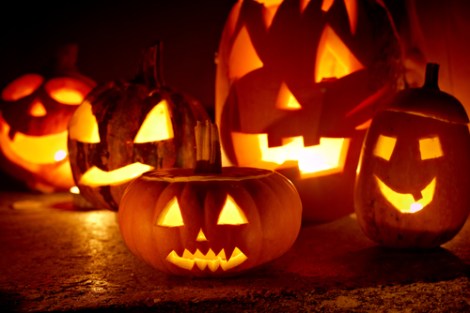I have a confession to make: I can go a little crazy for pumpkins. As fall sets in and I start seeing those huge boxes outside grocery stores piled high with cheap pumpkins, I often feel the need to take home five.
Can you blame me? Who doesn’t like the messy scooping, drawing, cutting, and candle-lighting involved in making a porch-load of grimacing jack-o’-lanterns? Of course, for me and other consumption-conscious, otherwise-organic-buying pumpkinphiles out there (ahem, raise your hands), this mires us in an ethical dilemma.
Here’s how the dialogue in my head went last year:
Voice of hedonism: Buying lots of pumpkins and cutting them up so they’ll eventually rot in front of your house is your right as an American. Plus, it’s fun!
Voice of conscience: But they’re food. And you are really careful about food. All the winter squash in your kitchen came from local farmers. So why should you get a free pass just because you’re planning to waste these ones?
Voice of hedonism: Look, they have big ol’ giant ones, classy white ones, and teenie tiny ones. Clearly you need one of each!
Voice of conscience: You’re right. Is anybody looking?
Like flowers, clothes, and well, just about everything that’s not edible, Halloween pumpkins really separate the casual organic consumers from the diehards. And I have been known to push the envelope in the latter category. (I might be nearing the end of my rope when it comes to buying non-organic cotton, for instance. I’ve just read too much about the sheer quantities of pesticides used to grow the stuff, and hearing that arsenic in rice grown in the South is the product of pesticides left over from cotton farming might just get me off those cheap H&M T-shirts for good.)
And compared to cotton, most people are generally aware of pumpkins as an agricultural product. But — here’s what’s kind of strange — most of the fresh pumpkins sold this month will be decorative. And I know I’m not alone in my desire to hoard them.
Last year, there was an actual pumpkin shortage in the Northeast because so many were waterlogged or split open after Hurricane Irene. This year numbers are down again due to the drought (this is not to be confused with the shortage of Starbucks pumpkin latte syrup that some customers have been reporting). But, according the Columbus Dispatch, in the Midwest, the overall acreage planted with pumpkins is trending upward. And that might just be because so many people go crazy and buy lots of cheap conventional ones. The article reads:
“All I can say is the pumpkin industry has exploded,” [Richard Snead, an agricultural statistician at the U.S. Department of Agriculture] said. “Production has been trending up in the last few years.”
U.S. farmers have consistently planted more acres of pumpkins each year. Last year’s 51,300 acres planted was up 25 percent from 2000, according to USDA statistics. That’s because pumpkins are a high-value crop for growers, said [Lisa] Schacht, who grows ornamental and pie pumpkins on the 120-acre farm she runs with her husband, David.
But it’s clear that pie pumpkins — most of which are apparently sold to Libby (a sub-brand of Nestlé) for one of America’s favorite canned, pureed holiday ingredient — aren’t the real cash crop.
“More money is spent at Halloween than on any other holiday except Christmas,” Schacht said. “Growers are going to grow for that.”
The truth is, there doesn’t seem to be much of a market for organic jack-o’-lantern pumpkins. (I can see why: It’d be hard for most shoppers to shell out the dough for an organic food they’ll never eat, especially if the pumpkins ended up costing more than their edible, conventionally grown counterparts). But one survey I found [PDF] did show that farmers-market customers said they’d be willing to pay between 20 and 30 percent more for insecticide-free pumpkins, including the decorative kind. And granted, farmers-market shoppers are already more biased toward thinking about organic farming as a solution to environmental problems, not just a way to keep the food they eat safe. But, in real terms, spending 30 or even 50 percent more for a pumpkin means, realistically, they might stick to buying one at a time.
And hey, it’s never a bad thing to have to put a little more thought into our consumption (otherwise, I predict another Hoarders spin-off dedicated purely to pumpkins and decorative gourds).
There is no doubt a small population of perfect, uber-conscious consumers will make it a habit of buying an organic pie pumpkin and simply drawing on it with a magic marker, instead of cutting it up, so they can save it to cook at Thanksgiving. (That sounds about as fun as recycling your Halloween costume and wrapping your Christmas gifts in recycled newspaper, doesn’t it?)
But for those of us who are not quite so perfect, the occasional organic jack-o’-lantern option might just provide some middle ground. (Paging farmers … ) Or — maybe this year I’ll get really retro and carve a turnip instead. I’ve heard that’s going to be all the rage in 2013.




